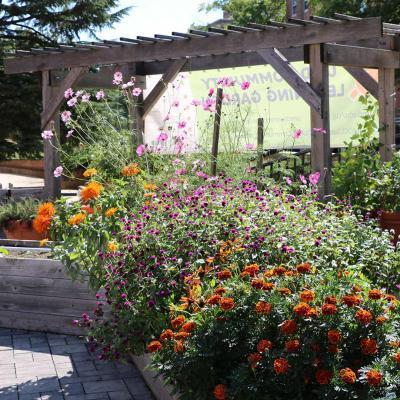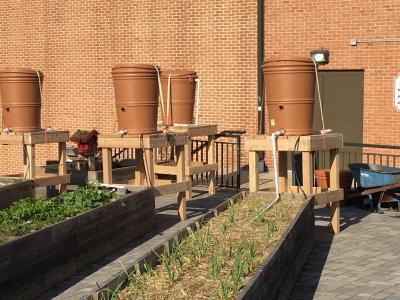Community Learning Garden

The Community Learning Garden (CLG) is a living classroom that educates visitors on the “importance of environmental stewardship, agricultural sustainability, physical activity and eating a balanced diet,” as well as issues surrounding community, public, and environmental health. The goal of those who manage the CLG is to encourage others to utilize green spaces to their fullest potential in innovative ways.The Community Learning Garden was founded in 2010 as the Public Health Garden, as a graduate student sustainability fund project and grew to become the work of students, faculty, and staff. The garden can be found between the Eppley Recreation Center and the School of Public Health at the University of Maryland.
The Community Learning Garden currently consists of five raised beds, six terraces, an orchard, and a tea garden. The raised beds serve as an ADA accessible area for teaching, established with the Institute of Applied Agriculture. The terraces behind the teaching garden are planted with crops for the Campus Pantry. When they are not in use, cover crops are planted to reduce erosion and improve soil quality. The terraces also serve as retaining walls that simultaneously create more space for the garden and help prevent erosion. The orchard features edible fruit trees, and the tea garden, which began as a student entrepreneurial project, features herbs that can be used in tea. The garden also hosts a number of different projects, including a sustainable irrigation system and bee research. The irrigation system collects stormwater from the nearby parking lot that flows into a bioretention facility, a swale that leads the water through a natural filtration system of soil, plant roots, and microbiota. The filtered water in the cistern is then pumped into the rain barrels to be stored until used in the drip-irrigation system. With regards to bee research, a wild bee study was conducted by students and faculty to study native miner bees. The bee research area is located in the corner of the garden by Eppley.

The CLG has significance within the UMD community. It provides many benefits to the campus, including serving as a venue for classes and research, as well as an area for relaxation. The garden donates to the Campus Pantry and hosts biweekly volunteer work hours during the semester. The produce grown in the garden is donated to the Campus Pantry, which aids Terps who are food insecure. In 2020, the garden shifted its focus to donating 100% of produce to the pantry in order to help alleviate the struggles experienced by the community due to the COVID-19 pandemic.
The Community Learning Garden relies on many partnerships from departments across UMD to ensure its success. These departments and organizations include the UMD Arboretum and Botanical Gardens, Facilities Management, the College of Agriculture and Natural Resources, the School of Public Health, Recreation & Wellness, Dining Services, the Office of Sustainability, and TerpFarm. With the help of these organizations, the student leadership team and volunteers are able to work to further develop the Community Learning Garden into a more sustainable, environmentally-friendly, and user-friendly place.
To get involved with the garden, members of the community can attend work hours to help with pruning, planting, weeding, planning, watering, and harvesting. Another way one can become involved with the garden is by utilizing the self-guided tour available for visitors of the garden.
Written by Senior Lead Campus Food Garden Intern, Amanda Sames
